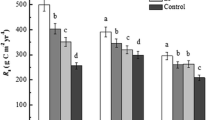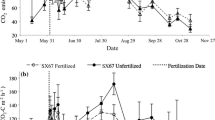Abstract
Perennial ryegrass swards were grown in large containers on a soil, at two N fertilizer supplies, and were exposed over two years in highly ventilated plastic tunnels to elevated (700 μL L-1 [CO2]) or ambient atmospheric CO2 concentration at outdoor temperature and to a 3°C increase in air temperature in elevated CO2. These swards were either fully irrigated (kept at field capacity) in each climatic condition (W+), or received the same amount of water in the three climate treatments (W-). In the latter case, the irrigation was adjusted to obtain a soil water deficit during summer and drainage in winter. Using a lysimeter approach, the evapotranspiration, the soil water balance, the productivity (dry-matter yield) and the water use efficiency of the grass swards were measured. During both years, elevated CO2 increased the annual above-ground drymatter yield of the W- swards, by 19% at N- and by 14% at N+. Elevated CO2 modified yield to a variable extent during the growing season: a small, and sometime not significant effect (+6%, on average) was obtained in spring and in autumn, while the summer growth response was stronger (+48%, on average). In elevated CO2, the temperature increase effect on the annual above-ground dry-matter yield was not significant, due to a gain in dry-matter yield in spring and in autumn which was compensated for by a lower summer productivity. Elevated CO2 slightly reduced the evapotranspiration during the growing season and increased drainage by 9% during winter. A supplemental 3°C in elevated CO2 reduced the drainage by 29–34%, whereas the evapotranspiration was increased by 8 and 63% during the growing season and in winter, respectively. During the growing season, the soil moisture content at W- and at the high N supply declined gradually in the control climate, down to 20–30% of the water holding capacity at the last cut (September) before rewatering. This decline was partly alleviated under elevated CO2 in 1993, but not in 1994, and was enhanced at +3°C in elevated CO2. The water use efficiency of the grass sward increased in elevated CO2, on average, by 17 to 30% with no significant interaction with N supply or with the soil water deficit. The temperature increase effect on the annual mean of the water use efficiency was not significant. Highly significant multiple regression models show that elevated CO2 effect on the dry-matter yield increased with air temperatures above 14.5°C and was promoted by a larger soil moisture in elevated compared to ambient CO2. The rate of change in relative dry-matter yield at +3°C in elevated CO2 became negative for air temperatures above 18.5°C and was reduced by a lower soil moisture at the increased air temperature. Therefore, the altered climatic conditions acted both directly on the productivity and on the water use of the grass swards and, indirectly, through changes in the soil moisture content.
Similar content being viewed by others
Abbreviations
- 350:
-
outdoor climate
- 700:
-
outdoor climate + 350 μL L-1 [CO2]
- 700+:
-
outdoor climate +350 μL L-1 [CO2] and + 3°C
- N-:
-
low N fertilizer supply
- N+:
-
high N fertilizer supply
- DM:
-
dry-matter
- ET:
-
evapotranspiration
- ETM:
-
maximal evapotranspiration
- WUE:
-
water use efficiency
- W-:
-
summer water limited swards
- W+:
-
fully irrigated swards
References
Ackerly D D, Coleman J S, Morse S R and Bazzaz F A 1992 CO2 and temperature increase effects on leaf area production in two annual species. Ecology 73, 1260–1269.
Adams W A and Akhtar N 1994 The possible consequences for herbage growth of waterlogging compacted pasture soils. Plant and Soil 162, 1–17.
André M and Du Cloux H 1993 Interaction of CO2 enrichment and water limitations on photosynthesis and water efficiency in wheat. Plant Physiol. Biochem. 31, 103–112.
Allen J L H 1990 Effects of increasing carbon dioxide levels and climate change on plant growth, evapotranspiration and water resources. In Managing Water Resources in the West under Conditions of Climate Uncertainty. pp 101–147. National Academy Press, Washington, DC, USA.
Arp W J 1991 Effects of source-sink relations on photosynthetic acclimation to elevated CO2. Plant Cell Environ. 14, 869–875.
Coleman J S and Bazzar F A 1992 Effects of CO2 and temperature on growth and resource use of co-occuring C3 and C4 annuals. Ecology 73, 1244–1259.
Eamus D 1991 The interaction of rising CO2 and temperatures with water use efficiency. Plant Cell Environ. 14, 843–852.
Falcimagne R, Martignac M and Soussana J F 1995 Un conditionnement climatique économique: utilisation d'un échangeur sol. In INRA, Direction de l'informatique (Eds.) 3éme journées de la Mesure, INRA Publ, pp 311–315. INRA, Versailles, France.
Gifford R M 1979 Growth and yield of CO2-enriched weat under water-limited conditions. Aust. J. Plant Physiol. 6, 367–378.
Grashoff C, Dijkstra S, Nonhebel S, Schapendonk A H C M and Van DeGeijn S C 1995 Effects of climate change on productivity of cereals and legumes; model evaluation of observed year-to-year variability of the CO2 response. Global Change Biol. 6, 417–428.
Ham J M, Owensby C E, Coyne P and Bremer D J 1995 Fluxes of CO2 and water vapor from a prairie ecosystem exposed to ambient and elevated atmospheric CO2. Agric. For. Meteorol. 77, 73–93.
Idso S B and Brazel A J 1985 Rising atmospheric carbon dioxide concentration may increase streamflow. Nature 312, 51–53.
Idso S B, Kimball B A and Mauney J R 1987 Atmospheric carbon dioxide enrichment effects on cotton midday foliage temperature: implications for plant water use and crop yield. Agron. J. 79, 667–672.
Jeffrey D W 1988 Mineral nutrients and the soil environment. In The Grass Crop. Eds. M BJones and ALazenby. pp 179–204. Chapman and Hall, London, UK.
Jones M B, Leafe E L and Stiles W 1980 Water stress in field-grown prennial ryegrass. II. Its effect on leaf water status, stomatal resistance and leaf morphology. Ann. Appl. Biol. 96, 103–110.
Jones H G 1992 Plants and microclimate. A quantitative approach to environmental plant physiology. 2nd ed. Cambride University Press, Cambridge, UK. 428 p.
Keeling C D, Whorf T P, Wahlen M and van derPflicht J 1995 Interannual extremes in the rate of rise of atmospheric carbon dioxide concentration since 1980. Nature 375, 666–670.
Kimball B A and Idso S B 1980 Increasing atmospheric CO2: effects on crop yield, water use, and climate. Agric. Water Manage. 7, 55–72.
Kimball B A, LaMorte R L, Seay R S, Pinter P JJr, Rokey R R, Hunsaker D J, Dugas W A, Heuer M L, Mauney J R, Hendrey G R, Lewin K F and Nagy J 1994 Effects of free-air CO2 enrichment on energy balance and evapotranspiration of cotton. Agric. For. Meteorol. 70, 259–278.
Kramer P J 1983 Water Relations of Plants. Academic Press, Orlando, FL, USA. 409 p.
Long S P 1991 Modification of the response of photosynthetic productivity to rising temperature by atmospheric CO2 concentration: has its importance been underestimated. Plant Cell Environ. 14, 729–739.
Mitchell J F B, Johns F C, Gregory J M and Telt S F B 1995 Climate response to increasing levels of greenhouse gases and sulphate aerosol. Nature 376, 501–504.
Morison J I L 1987 Intercellular CO2 concentration and stomatal response to CO2. In Stomatal Function. Eds. EZeiger, ICowan and G DFarquhar. pp 229–251. Stanford University Press, Stanford, USA.
Morison J I L 1993 Response of plants to CO2 under water limited conditions. Vegetatio 104/105, 193–209.
Morison J I L and Gifford R M 1984 Plant growth and water use with limited water supply in high CO2 concentrations. I. Leaf area, water use and traspiration. Aust. J. Plant Physiol. 11, 361–374.
Newton P C D, Clark H, Bell C C, Glasgow E M and Campbell B D 1994 Effects of elevated CO2 and simulated seasonal changes in temperature on the species composition and growth rates of pasture turves. Ann. Bot. 73, 53–59.
Nijs I, Impens I and Behaeghe T 1988 Effects of rising carbon dioxide concentration on gas exchange and growth of perennial ryegrass. Photosynthetica 22, 44–50.
Nijs I, Impens I and Behaeghe T 1989 Leaf and canopy responses of Lolium perenne to long-term elevated atmospheric carbondioxide concentration. Planta 177, 312–320.
Nijs I and Impens I 1993 Effects of long-term elevated atmospheric carbon dioxide on Lolium perenne and Trifolium repens, using a simple photosynthesis model. Vegetatio 104/105, 421–431.
Owensby C E, Coyne P I, Ham J M, Auen L M and Knapp A K 1993 Biomass production in a tallgrass prairie ecosystem exposed to ambient and elevated CO2. Ecol. Applications 3, 644–653.
Penman H L 1956 Dicussions of evaporation. Neth. J. Agric. Sci. 4, 87–97.
Ryle G J A, Powell C E and Tewson V 1992 Effect of elevated CO2 on the photosynthesis, respiration and growth of perennial ryegrass. J. Exp. Bot. 43, 811–818.
Schenck U, Manderscheid R, Hugen J and Weigel H J 1995 Effects of CO2 enrichment and intraspecific competition on biomass partitioning, nitrogen content and microbial biomass carbon in soil of perennial ryegrass and white clover. J. Exp. Bot. 46, 987–993.
Soussana J F, Casella E and Loiseau P 1996 Long-term effects of CO2 enrichment and temperature increase ona temperate grass sward. II. Plant nitrogen budgets and root fraction. Plant and Soil 182.
Van Loo 1992 Tillering, leaf expansion and growth of plants of two cultivars of perennial ryegrass grown using hydroponics at two water potentials. Ann. Bot. 70, 511–518.
Watson R T, Rodhe H, Oescheger H and Siegenthaler U 1990 Greenhouse gases and aerosols. In Climate: the IPCC Scientific Assessment. Eds. J THoughton, G JJenkins and J JEphranums. pp 1–40. Cambrige Univ. Press, Cambridge, UK.
Author information
Authors and Affiliations
Rights and permissions
About this article
Cite this article
Casella, E., Soussana, J.F. & Loiseau, P. Long-term effects of CO2 enrichment and temperature increase on a temperate grass sward. Plant Soil 182, 83–99 (1996). https://doi.org/10.1007/BF00010998
Received:
Accepted:
Issue Date:
DOI: https://doi.org/10.1007/BF00010998




